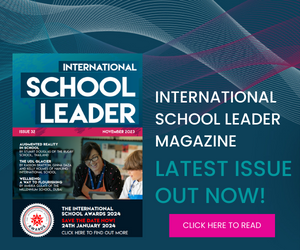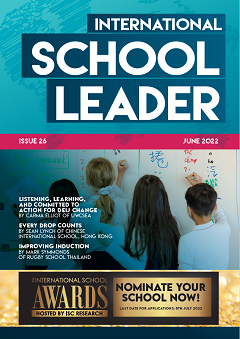By Ambika Gulati
At The Millennium School Dubai (TMS), a 23-year old K-12, Indian curriculum (CBSE) school serving the Indian diaspora in the United Arab Emirates, the journey of fostering a culture of wellbeing commenced in December 2019, actuated by the results of the Dubai Student Wellbeing Census (DSWC) conducted by the Knowledge and Human Development Authority, the private education regulator in Dubai.
We found that there were several areas, such as emotional regulation and perseverance, that needed focus to nurture student wellbeing and thus began the search for exploring wellbeing frameworks, creating an action plan and building an understanding of the relevance of wellbeing within the school community. This was accelerated by the onset of COVID-19.
The school’s vision of nurturing mindful global citizens is achieved through its commitment to the five pillars of wellbeing: cognitive, spiritual, physical, emotional and social. The school firmly believes that student wellbeing underpins effective learning.
This article details one of the major elements within the school’s wellbeing strategy: the development and implementation of the Mental Toughness Programme (MTP), using John Kotter’s model of change management. The MTP equips young people with tools and strategies to navigate the complexities of their social and emotional needs.
As a culture of wellbeing began to foster within the stakeholders, it became imperative to ensure that it would be embedded and sustained. This objective was achieved by making wellbeing a priority in the annual school improvement plan.
Create urgency
The starting point of any change management effort is to create a sense of urgency with stakeholders as this allows for their buy-in to the proposed changes. At TMS, this sense of urgency was created by two events: the data that was received from the DSWC in December 2019, and the onset of COVID-19 in March 2020. The school’s leadership realised there was a need to initiate a stand-alone programme (the MTP), despite its motto of ‘we choose to care’ that guided all efforts.
Form a guiding coalition
Any change effort requires champions who believe in the effort and are willing to extend themselves to work through the nuances of implementing the change. Very early on, the school’s leadership realised that it would not be able to achieve the required curriculum and external support from a researcher in the field of positive psychology would be essential. Thus, in the early days, a group of student counsellors who were excited and passionate about delivering this curriculum spent substantial time with the external researcher to create modules that would be piloted across all grades of the middle school.
Develop a vision and strategy
Kotter emphasises the importance of developing a vision and sharing the strategy with community members who will be impacted through the change effort. This allows people to see the road ahead, clarifying what they may expect. The wellbeing strategy at TMS was developed around five pillars of wellbeing mentioned above.
Every year, we review the strategy and align it with the latest research in positive psychology. For example, we began with our wellbeing strategy with the tagline ‘thrive for life’, but soon felt that, instead of ‘thrive’, we needed a broader and deeper word, and changed it to ‘flourish for life’ ‘Flourish’ is related to a sense of purpose in one’s life, and this better aligned with TMS’s ethos.
Communicate the vision
Once the team developed the strategy for wellbeing, it needed to be communicated to all stakeholders (parents, students and staff). We realised that communication is critical to the success of any change management initiative, and stakeholders need a constant reminder of the ‘what and why’ of the change effort. Thus, expressing the vision only at the launch of the MTP was insufficient and needed reiteration. In addition, we asked our expert to orient our parents and teachers on how the MTP would benefit young minds. This is a process that we have continued despite being in the fourth year of implementation. Communication is key to remind stakeholders that wellbeing is at the core of everything that we do at TMS as ‘we choose to care’.
Remove barriers to action
The biggest challenge for any leadership team is to create the necessary buy-in for the change initiative. When the idea of the MTP was proposed, several concerns were raised, ranging from how it would compromise instructional time, to teachers not being experts, to delivering a social-emotional curriculum.
This led the core team to think innovatively and deliver on a solution of self-paced modules that harnessed technology. The self-paced interactive lessons on Nearpod changed the way in which the typical middle-school student approached a programme of this nature. The self-regulated and personalised nature of MTP lessons allowed students to engage with the topics at their own pace and level of maturity. Fortnightly interactions with students to evaluate impact gave ownership and voice to students and created interest and engagement. Mid-point surveys were conducted to capture student feedback. Open channels of communication to understand how modules could be more student-centred built trust and the success of these modules has cascaded into academic subjects, with 82% of our students strongly agreeing that they enjoy learning through such channels.
Accomplish short-term wins
As the programme commenced its journey, it became increasingly important for the school to share the students’ voices with the larger community. Students actively reached out to our team to suggest modules as well as to request additional information on topics such as breaking down bullying and sharing specific strategies to cope. This led to the creation of a resource bank that was made accessible to all students. We also took biannual surveys to review the efficacy of the programme and used the data to make changes to the curriculum (such as adding modules on coping skills for stress management).
Build on change
The small wins led to a snowball effect. Parents who had children in grades other than the middle years began requesting a similar programme. This led to the creation of a vertical escalation for the MTP, which is built around seven pillars. Student survey data feeds into the curriculum plan, making it a bespoke programme. For example, during the 2023–2024 academic year, we have introduced ‘executive functioning’ modules for students, based on the results of the student survey. In addition, our students hosted several wellbeing conclaves, where more than 400 students from Round Square schools participated. Within the school, we were able to bifurcate the wellbeing and inclusion teams to provide the much needed impetus to wellbeing. We also reached out to the parent community through our Weekend Sharing communication channel that counsellors use to share wellbeing tips with parents.
Making it stick
As a culture of wellbeing began to foster within the stakeholders, it became imperative to ensure that it would be embedded and sustained. This objective was achieved by making wellbeing a priority in the annual school improvement plan. The school also appointed student wellbeing champions who actively created and implemented ideas that nurture wellbeing within the school community. One such initiative was “‘adopt a class’. The teacher wellbeing committee – our Joy Radiators – organised several wellbeing events within the school calendar. The school holds itself accountable to its governors as it reports on wellbeing initiatives and outcomes every quarter.
The journey of embedding the MTP at the school over the last three years has allowed us to think deeply about change management, leadership and wellbeing. The lessons learnt from piloting it in the middle school then expanding it to the senior and primary years are now being applied to other programmes that the school would like to implement. The bespoke programme continues to evolve year-on-year to meet the needs of our students.
As a school leader wanting to implement change, it would be beneficial to use evidence to identify gaps at your school and use research-based strategies to bridge these gaps. Team empowerment, stakeholder buy-in and using data to monitor and evaluate impact is essential. However, everything may not go as per plan, and you need to be an adaptive leader to effect transformational change.

Ambika Gulati has nearly 25 years of leadership experience in the K-12 sector. She is passionate about transforming pedagogical practices and embedding data-driven systems of managing change that positively impact student achievements. You can contact Ambika on LinkedIn or by email at [email protected]



